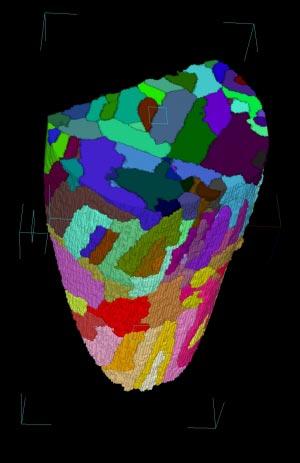
Physicists in Europe are the first to obtain 3D images of magnetic domains – regions within a material in which all the magnetic moments point in the same direction. While 2D magnetic domains on surfaces can be imaged using several different techniques, 3D images have eluded scientists since such magnetic domains were first proposed over 100 years ago. As well as providing better insight into how domains form and evolve, the technique could also help to improve hard disks – which store data in magnetic domains.
Below a critical temperature the magnetic moments in a ferromagnetic material such as iron tend to point in the same direction as their neighbours. In the absence of an applied magnetic field, however, all the moments in an iron sample will not always point in the same direction. Instead microscopic regions – called domains – can form whereby all the moments of one domain will point in one direction, while all the moments of a neighbouring domain may point in a different direction.
While physicists have been able to study the effect of domains on the magnetic properties of materials, they had not been able to make 3D images of domains deep within the bulk of a material. Instead they had to settle on destructive techniques such as imaging domains near the surface of the sample and then shaving off a thin layer and repeating the measurement.
Talbot-Lau neutron tomography
But now Ingo Manke and Nikolay Kardjilov of the Helmholtz Centre Berlin and colleagues in Germany, Switzerland and the UK have created the first 3D images using a new technique called Talbot-Lau neutron tomography. They did this by firing a coherent beam of low-energy neutrons at a sample of an iron-silicon alloy. A small number of the neutrons are deflected slightly when they cross a boundary between two domains. This deflection occurs because the index of refraction of the material changes abruptly at the boundary. A diffraction grating with a detector behind it is scanned across the beam of deflected neutrons to determine the angle of deflection.
This measurement is repeated many times as the sample is rotated through 360°. The data are then fed into a computer program developed by the team, which produces a 3D image of the domains. The images have a spatial resolution of about 35 μm, which Manke and Kardjilov say could be improved to about 1 μm by using a neutron detector with a better spatial resolution and a higher neutron flux.
‘Significant advance’
Bruce Gaulin of McMaster University in Canada told physicsworld.com, “I am very impressed with the quality of the 3D visualization of the magnetic domains and the quantitative analysis that this quality of data enables.” Gaulin, who was not involved in the research, added that the work represents “a significant advance and I would expect it to allow much more detailed understanding of domain structures in materials of practical interest”.
As well as improving their experimental set-up, the team is also developing better ways to interpret the data. The team also plans to use the technique to put magnetic-domain theories to the test and to make measurements in strong magnetic fields.
The work is describe in Nature Communications DOI:10.1038/ncomms1125.



